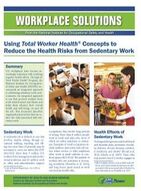
November 2019 Synergist Article
Three new NIOSH “Workplace Solutions” documents published in October offer recommendations regarding protections for workers from noise, Legionella, and cold. Written for a general audience, the Workplace Solutions series summarizes the current understanding of specific hazards, describes relevant regulations and nonregulatory guidance, provides short case studies that illustrate the application of protections, and offers recommendations for both employers and workers.
In “Using Total Worker Health Concepts to Address Hearing Health,” NIOSH explains the risk factors that affect hearing both on and off the job and recommends using concepts from the agency’s Total Worker Health initiative, or TWH, to protect hearing health. TWH involves policies, programs, and practices that integrate protection from work-related safety and health hazards with promotion of injury and illness prevention efforts. The document explains relevant noise exposure limits and summarizes research related to occupational, nonoccupational, and environmental factors that affect noise exposure. In addition to recommendations for employers and workers, the document lists several recommendations for medical professionals to incorporate “total hearing health” into clinical practice.
“Preventing Occupational Exposure to Legionella” explains the sources of Legionella and summarizes guidelines to control exposure, including those from CDC, OSHA, EPA, and AIHA. A case study discusses a NIOSH investigation of a car and scrap metal shredding facility that identified Legionella in equipment and standing puddles.
The document “Preventing Cold-Related Illness, Injury, and Death among Workers” explains possible health outcomes from exposure to cold, including chilblains, trench foot, frostbite, and hypothermia. Case studies describe health effects from occupational exposures at an airline catering facility and a sheep ranch.
All NIOSH Workplace Solutions documents are available from the agency website.
Three new NIOSH “Workplace Solutions” documents published in October offer recommendations regarding protections for workers from noise, Legionella, and cold. Written for a general audience, the Workplace Solutions series summarizes the current understanding of specific hazards, describes relevant regulations and nonregulatory guidance, provides short case studies that illustrate the application of protections, and offers recommendations for both employers and workers.
In “Using Total Worker Health Concepts to Address Hearing Health,” NIOSH explains the risk factors that affect hearing both on and off the job and recommends using concepts from the agency’s Total Worker Health initiative, or TWH, to protect hearing health. TWH involves policies, programs, and practices that integrate protection from work-related safety and health hazards with promotion of injury and illness prevention efforts. The document explains relevant noise exposure limits and summarizes research related to occupational, nonoccupational, and environmental factors that affect noise exposure. In addition to recommendations for employers and workers, the document lists several recommendations for medical professionals to incorporate “total hearing health” into clinical practice.
“Preventing Occupational Exposure to Legionella” explains the sources of Legionella and summarizes guidelines to control exposure, including those from CDC, OSHA, EPA, and AIHA. A case study discusses a NIOSH investigation of a car and scrap metal shredding facility that identified Legionella in equipment and standing puddles.
The document “Preventing Cold-Related Illness, Injury, and Death among Workers” explains possible health outcomes from exposure to cold, including chilblains, trench foot, frostbite, and hypothermia. Case studies describe health effects from occupational exposures at an airline catering facility and a sheep ranch.
All NIOSH Workplace Solutions documents are available from the agency website.

